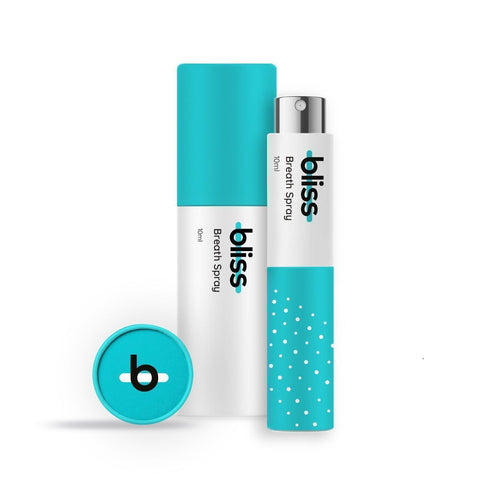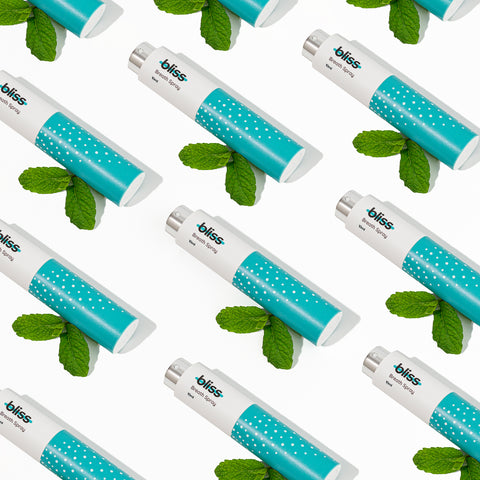The Science of Fresh Breath Sprays

In the world of first impressions, fresh breath often plays a starring role. It's not just about being presentable—it's also a marker of hygiene, health, and attention to detail.
When it comes to combating bad breath, we've all had our turn with the classics. The cool tingle of a mint melting on your tongue, the rhythmic chewing of gum, especially after a particularly garlicky meal, or the invigorating rush of a mouthwash swished vigorously around the mouth. These remedies have become our go-to solutions, accompanying us in purses, pockets, and bathroom cabinets.
However, in our fast-paced modern life, where convenience is king, there's another hero emerging in the quest for pristine breath—breath sprays. Compact, quick, and efficient, these little bottles promise freshness in just a spritz.
But how do they work their magic? Dive in with us as we explore the science behind these pocket-sized wonders.
"Check out - Bliss Breath Spray, perfect for on-the-go freshness.
The Science Behind Bad Breath
Bad breath, also known as halitosis, can result from a variety of factors, both temporary and chronic. It's important to note that bad breath is a common problem, and many cases can be managed or treated effectively. Here are some of the key factors contributing to bad breath:
-
Oral Hygiene: Poor oral hygiene is a primary cause of bad breath. When food particles remain in the mouth, bacteria break them down and release foul-smelling gases. Brushing teeth, tongue, and gums regularly, as well as flossing, can help remove these particles and prevent bacterial growth.
-
Bacterial Activity: The mouth naturally hosts a complex ecosystem of bacteria. Some of these bacteria can produce sulphur compounds, which emit a strong odour. These compounds are often responsible for the unpleasant smell associated with bad breath.
-
Dry Mouth (Xerostomia): Saliva plays a crucial role in maintaining oral health by rinsing away food particles and neutralising acids produced by bacteria. A dry mouth provides an environment where bacteria can thrive and produce foul-smelling compounds. Dry mouth can be caused by factors like certain medications, medical conditions, or mouth breathing.
-
Diet: Certain foods, like garlic, onions, and spices, contain strong-smelling compounds that can linger in the mouth and be carried into the bloodstream, causing temporary bad breath. Sugary foods can also contribute to bad breath by promoting bacterial growth.
-
Tobacco and Alcohol: Smoking and chewing tobacco products can lead to a distinct and lasting odour. Alcohol consumption can also contribute to dry mouth, which in turn can lead to bad breath.
-
Medical Conditions: Various medical conditions can lead to bad breath. These include respiratory infections, sinusitis, gastroesophageal reflux disease (GERD), diabetes, liver and kidney problems, and more. These conditions can contribute to bad breath by releasing specific chemicals or by causing dry mouth.
-
Poorly Fitting Dental Appliances: Dentures, braces, and other dental appliances can trap food particles and bacteria, leading to bad breath if not cleaned properly.
-
Tongue Coating: The rough surface of the tongue can collect bacteria and food particles, creating a coating. This coating can produce odours as bacteria break down the trapped material.
-
Morning Breath: During sleep, saliva production decreases, and the mouth becomes a favourable environment for bacterial growth. This is why many people experience bad breath in the morning.
Ingredients Commonly Found in Breath Sprays

Breath sprays are designed to provide a quick and convenient solution for freshening breath on the go. They typically contain ingredients that help mask or neutralise odour-causing compounds in the mouth.
While the specific formulations can vary between brands and products, here are some common ingredients you might find in breath sprays:
-
Flavouring Agents: Breath sprays often contain flavouring agents to provide a pleasant taste and mask any unpleasant odours. Common flavours include mint, spearmint, peppermint, cinnamon, and fruity flavours.
-
Sweeteners: Sweeteners like xylitol or sorbitol are added to enhance the taste of the breath spray. Xylitol can also help inhibit the growth of certain bacteria that contribute to bad breath.
-
Alcohol: Breath spray helps kill bacteria. Many breath sprays contain alcohol, such as ethanol or isopropanol. Alcohol helps kill bacteria in the mouth and evaporates quickly, providing a temporary feeling of freshness. However, excessive alcohol content can contribute to dry mouth, so some products opt for alcohol-free formulations.
-
Antibacterial Agents: Some breath sprays include antibacterial agents like cetylpyridinium chloride or chlorhexidine. These compounds help reduce the population of odour-causing bacteria in the mouth.
-
pH-Adjusting Agents: Maintaining a balanced pH in the mouth can help prevent the growth of odour-causing bacteria. Breath sprays might contain pH-adjusting agents to create an environment less favourable for bacterial growth.
-
Essential Oils: Essential oils like peppermint, spearmint, eucalyptus, and thyme are commonly used in breath sprays for their natural antibacterial properties and pleasant aroma.
-
Humectants: Humectants like glycerine are added to prevent the spray from drying out quickly and to maintain moisture in the mouth.
-
Fluoride: Some breath sprays incorporate fluoride, which can help strengthen tooth enamel and protect against cavities.
-
Natural Extracts: Some products may include natural extracts such as green tea, aloe vera, or chamomile for their potential antibacterial or soothing properties.
-
Emulsifiers and Stabilisers: These ingredients help maintain the consistency and stability of the spray formulation.
How Breath Sprays Work
Breath sprays primarily work through the following mechanisms:
A. Immediate Masking of Odour:
One of the main functions of breath sprays is to provide a quick and temporary solution for masking unpleasant odours. They contain flavouring agents that impart a pleasant smell to the breath, helping to cover up the odour caused by bacteria and other compounds in the mouth.
B. Neutralisation of Bad-Breath-Causing Compounds:
Some breath sprays contain ingredients that can chemically neutralise or counteract the compounds responsible for bad breath. For example, certain compounds in the spray might react with sulphur compounds produced by bacteria, reducing their odour impact.
C. Killing or Inhibiting the Growth of Bacteria:
Some breath sprays incorporate antibacterial agents like cetylpyridinium chloride, chlorhexidine, or essential oils. These agents can target and kill bacteria that cause bad breath, reducing the population of odour-causing microorganisms. By reducing bacterial growth, breath sprays can contribute to fresher breath.
D. Stimulation of Saliva Production:
Saliva plays a crucial role in maintaining oral health and neutralising acids produced by bacteria. Some breath sprays may contain ingredients that stimulate saliva production. Increased saliva flow helps rinse away food particles, bacteria, and odour-causing compounds, which can lead to fresher breath.
Advantages of Breath Sprays
Breath sprays offer several advantages for individuals seeking a quick and convenient solution to freshen their breath. Here are some of the benefits of using breath sprays:
Portability:
Breath sprays are highly portable and compact, making them easy to carry in pockets, purses, or even on key chains. This portability ensures you can have them readily available whenever you need them.
Instant Freshness:
Breath sprays provide immediate relief from bad breath. With just a quick spray, you can experience a noticeable improvement in breath odour, which is especially helpful when you're in situations where you want fresh breath confidence. Some breath sprays also help kill bacteria that cause bad breath and leave your mouth feeling instantly clean and minty fresh. Ideal for a handbag, desk drawer or wherever you need fresh breath and confidence.
Longer Lasting Effect Compared to Mints or Gum:
Some breath spray brands are designed to offer longer-lasting freshness compared to traditional minty fresh sugar-free chewing gum. This can be particularly beneficial if you're looking for a solution that provides extended relief without needing to constantly consume mints or gum.

Frequently Asked Questions
1) How do breath sprays maintain fresh breath?
Breath sprays contain cool mint flavours for instant freshness and antimicrobial agents to target odour-causing bacteria. These agents help control bad breath at its source, making breath sprays effective in maintaining a pleasant oral environment.
2. How do breath spray ingredients combat bad breath?
Breath sprays use antimicrobial agents, like menthol and essential oils, to eliminate bacteria producing bad breath. Flavourings mask odours, giving immediate freshness. This combination tackles the root causes of bad breath, making breath sprays effective in fighting unwanted odours.
3. Are mouth sprays a long-lasting solution?
Mouth sprays provide quick relief by masking odours and killing bacteria. However, for lasting freshness, integrate them with regular oral care like brushing, flossing, and mouthwash. Address underlying oral issues and maintain a holistic oral hygiene routine for sustained fresh breath.


